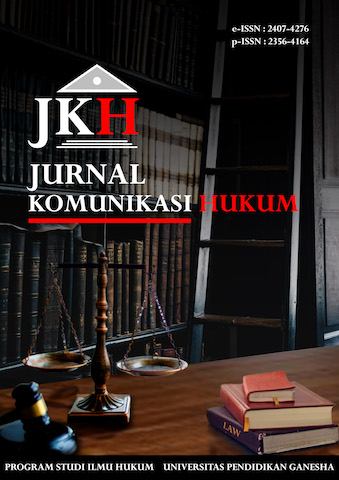KEPASTIAN HUKUM TINDAK PIDANA PENGHINAAN CITRA TUBUH (BODY SHAMING) DI MEDIA SOSIAL
Abstract
Everyone has the right to socialize and interact in a good and conducive social environment. The negative impact of technological advances in social life in society causes body shaming to occur easily. The legal rules regarding body shaming in the Electronic Information and Transactions Law (UUITE) are unclear, causing multiple interpretations, therefore it is necessary to study the rules relating to insults in order to create legal certainty. Based on this, it is very interesting to discuss the issue of how to regulate the crime of body shaming on social media in terms of Law Number 19 of 2016 concerning Information and Electronic Transactions (UU ITE) and the elements in the crime of body shaming on social media. This type of research is descriptive normative legal research, because of the blurring of norms in the ITE Law Article 27 paragraph (3). This study uses statutory and conceptual approaches, legal materials using primary, secondary and tertiary legal materials. The results of this study are the regulation of body shaming on social media in terms ofITE Lawindeed there is no article that specifically mentions body shaming, there is only a clause “insulting/defaming”. Because in body shaming there are victims who feel humiliated and their good names are tarnished. Thus Article 27 paragraph (3)ITE LawUntil now it is still relevant to use in cases of criminal acts of body shaming if the action is carried out using a computer and internet network. The elements of the criminal act of body shaming on social media are: everyone, intentionally, without rights, distributes and/or transmits and/or makes electronic information and/or electronic documents accessible, contains insults and/or defamation.
Downloads
Published
How to Cite
Issue
Section
License
Authors who publish with this journal agree to the following terms:- Authors retain copyright and grant the journal right of first publication with the work simultaneously licensed under a Creative Commons Attribution License that allows others to share the work with an acknowledgement of the work's authorship and initial publication in this journal.
- Authors are able to enter into separate, additional contractual arrangements for the non-exclusive distribution of the journal's published version of the work (e.g., post it to an institutional repository or publish it in a book), with an acknowledgement of its initial publication in this journal.
- Authors are permitted and encouraged to post their work online (e.g., in institutional repositories or on their website) prior to and during the submission process, as it can lead to productive exchanges, as well as earlier and greater citation of published work (See The Effect of Open Access).
Authors who publish with this journal agree to the following terms:
- Authors retain copyright and grant the journal right of first publication, with the work [SPECIFY PERIOD OF TIME] after publication simultaneously licensed under aCreative Commons Attribution License that allows others to share the work with an acknowledgement of the work's authorship and initial publication in this journal.
- Authors are able to enter into separate, additional contractual arrangements for the non-exclusive distribution of the journal's published version of the work (e.g., post it to an institutional repository or publish it in a book), with an acknowledgement of its initial publication in this journal.
- Authors are permitted and encouraged to post their work online (e.g., in institutional repositories or on their website) prior to and during the submission process, as it can lead to productive exchanges, as well as earlier and greater citation of published work (See The Effect of Open Access).












